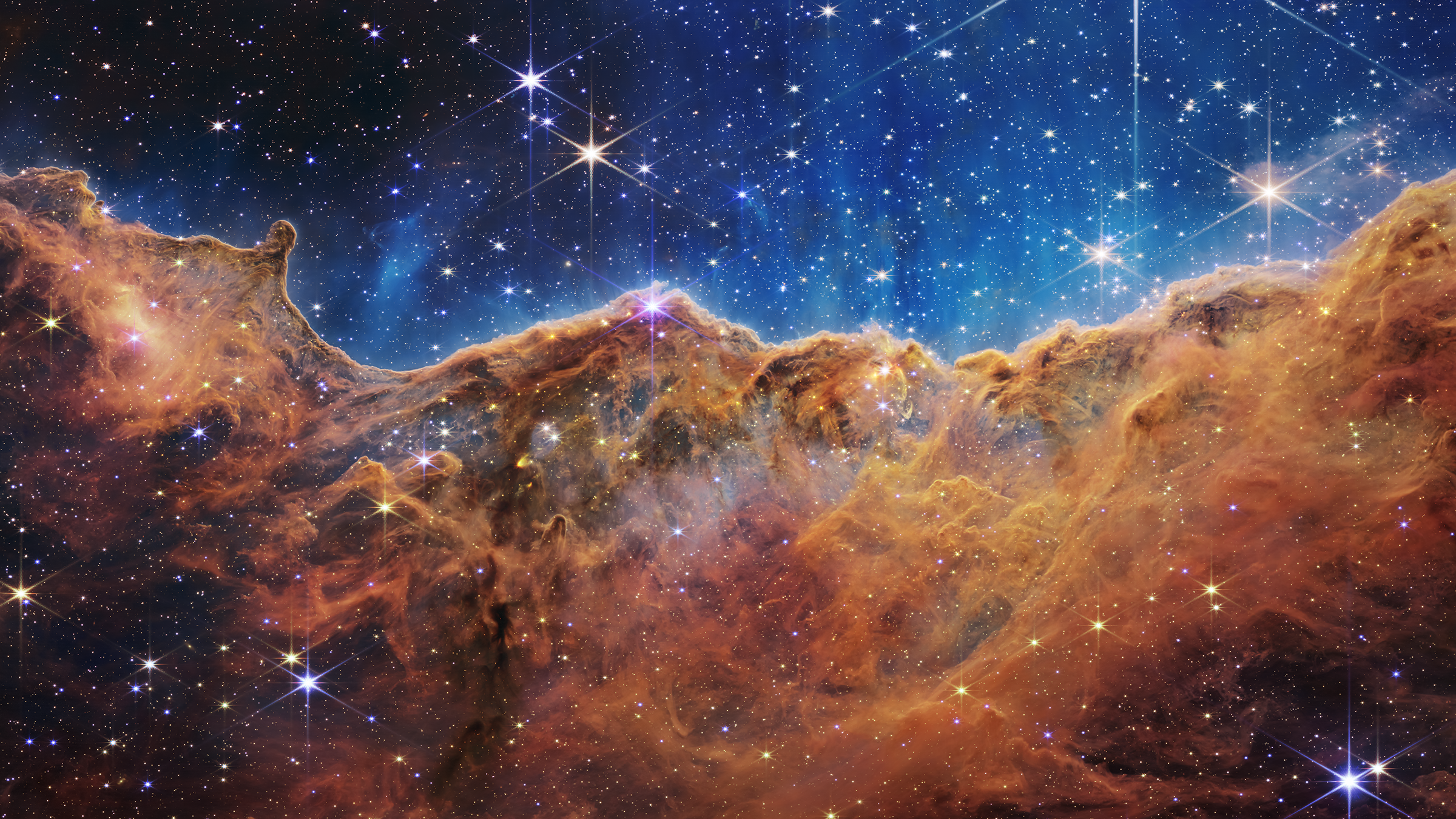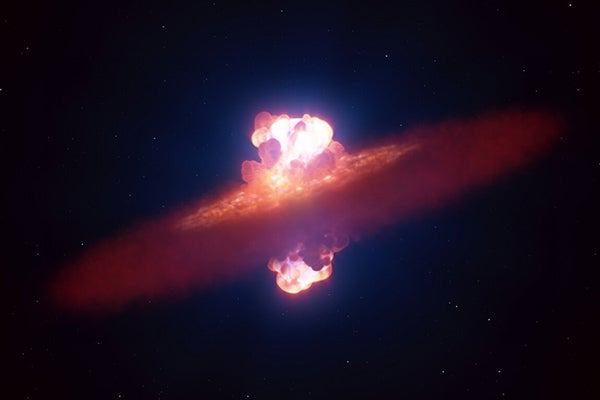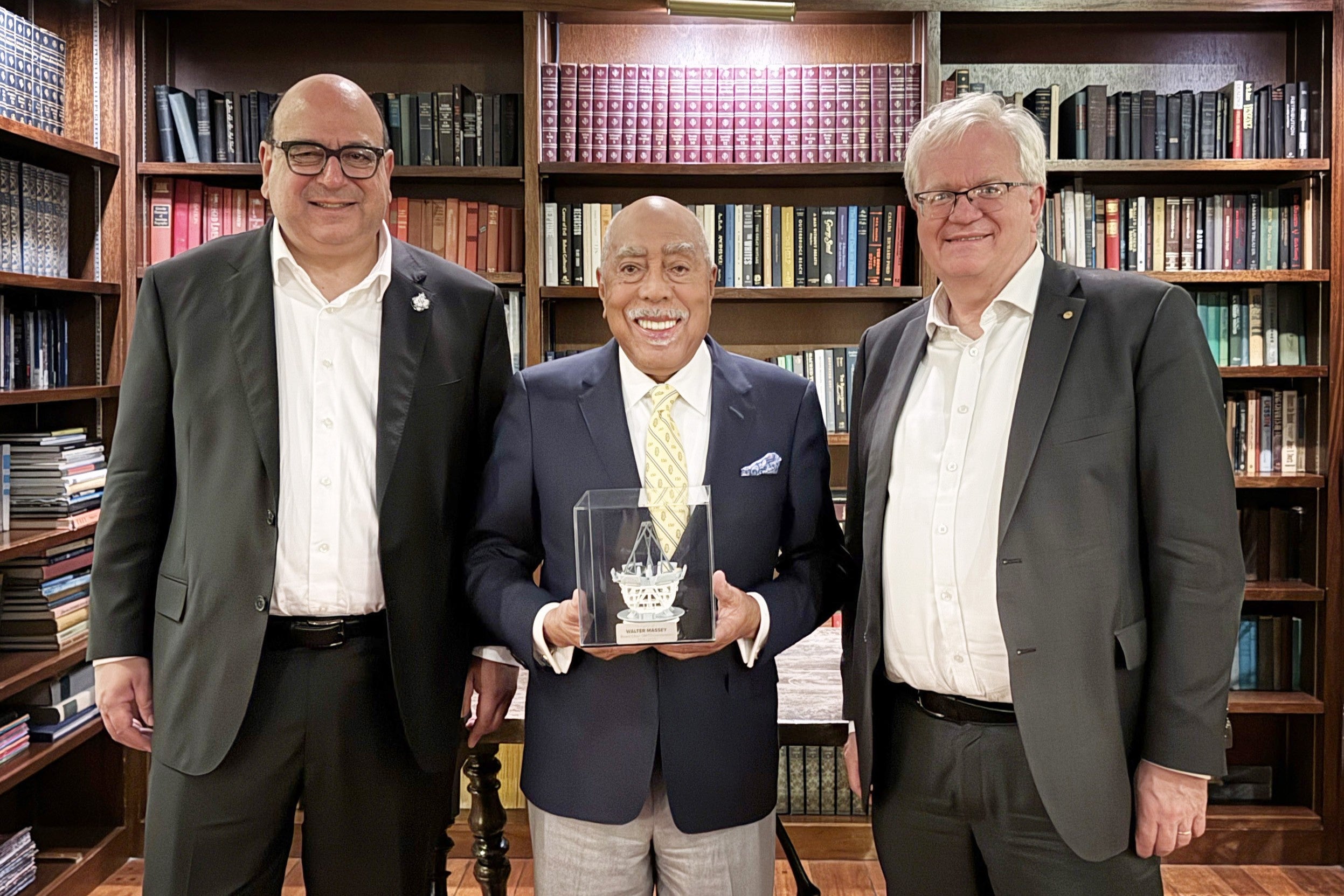Right Place, Right Time
Like the Hubble Space Telescope before it, the James Webb Space Telescope has the potential to change the course of astronomy.

For graduate student Olivia Cooper, the successful launch of the James Webb Space Telescope, or JWST, comes at the perfect time to help launch her career studying galaxy evolution. Cooper works with University of Texas at Austin associate professor Caitlin Casey on the biggest project in JWST's first year—COSMOS-Web—which is designed to take the deepest images of the universe to date and reveal some of the earliest galaxies to form after the Big Bang. We talk with Cooper about the breathtaking images JWST is collecting, the complicated legacy of the telescope's namesake, why her fellow scientists are just as inspiring as JWST itself and what this moment means to her.
TRANSCRIPT
Caitlin Casey: So what we're doing with COSMOS-Web is we are attempting to take one of the deepest images of the distant cosmos ever taken. … to then piece together the ultimate history of everything. We're going all the way back to the beginning of time, when the universe was extremely young, over 13 billion years in the past, trying to piece together how the first galaxies formed ...
Marc Airhart: That's Caitlin Casey, a co-leader of the largest international project right now on the James Webb Space Telescope, or JWST, the most powerful space telescope ever made. She was speaking to The Texas Standard on Austin's public radio station KUT ahead of the telescope's launch last Christmas. Today, we're spotlighting one of her graduate students who is lucky enough to be on the ground floor of one of the most exciting developments in modern astronomy.
Olivia Cooper: And we sat in a room together and watched the images come onto the screen. And it was this amazing moment -- everybody like gasped …
MA: Last summer, graduate student Olivia Cooper was at a meeting in Paris when the first JWST images were released. One image looked like orange foam churning on the surface of a blue-black sea, riddled with shiny jewels. Another showed a pileup of five twirling galaxies ripping at each other's seams. A third looked like a bowl of galaxy soup after a good stir. You didn't have to be an astronomer to appreciate these fantastical images.
OC: But we were especially excited looking at the spectrum of a redshift 8 galaxy, which just looks like some squiggly lines. But those lines mean a lot to us as astronomers.
MA: Still, there's something about beautiful images that brings astronomy alive.
OC: I think it was only real for me when I saw those first images in July. That was the … moment of awe and wonder and gratitude that it all worked out.
MA: This is Point of Discovery. I'm Marc Airhart. Both Casey and Cooper are in the Department of Astronomy at The University of Texas at Austin. The effort they are a part of, COSMOS-Web, is using more time on JWST in its first year of operation than any other project. With more than 250 hours of observations, the project is hunting for the first galaxies in the universe. And it all began, back when JWST launched into space on Christmas Day, 2021.
MA: What followed that Christmas-morning launch was a gift for early-career scientists like Cooper. It got us wondering what it's like to be in her shoes during our current, history-making moment in science. But let's back up a second. The predecessor to JWST was the Hubble Space Telescope, which ruled supreme as the titan of telescopes for over 30 years. Its iconic images inspired a whole generation of future astronomers—and were the raw material that careers were made on.
OC: … starting in astronomy, I've always had Hubble around. And I think a generation or two ahead of me are, they're sort of defined by Hubble in a way, at least in certain areas of the field. And it has been the best thing around for a while, and it's amazing.
MA: Breathtaking Hubble Space Telescope images hooked Cooper as an undergraduate, on the topic she has continued to pursue for her graduate studies: mysterious galaxies that are busy forming lots of new stars that remain hidden behind a dusty veil. They're appropriately called "dusty star-forming galaxies."
OC: Yeah, I like, honestly, pretty pictures. So the first project with dusty star-forming galaxies that I worked on, was lensed galaxies. So these images of galaxies that are sort of warped and stretched and magnified, and some of them look like these long tails, and some of them look like eggs, like wrapped in a circle and all these filamentary structures. And that's not actually what the galaxies look like. … it's just a consequence of general relativity, where there is another massive galaxy in the foreground.
MA: The galaxy in front warps space and time, kind of like a lens, so that light from the galaxy behind it bends in weird ways.
OC: So it's sort of like having a wineglass on a newspaper. You see the words are magnified and stretched out.
MA: Cooper was trying to take those distorted images and figure out what the galaxies in the back, behind the wineglass, really looked like. With JWST, new possibilities to do that research have opened up. To Cooper, it feels like another generation-defining moment for astronomy. After all, NASA had originally planned to launch JWST in 2007—but the project was repeatedly delayed. By the time of last year's launch, some recent students had already missed out. But Cooper had the chance to be among the first researchers to learn from its mind-bending capabilities.
OC: Yeah, it totally feels like right place, right time… it does feel like it sort of defines my generation. And I feel super lucky that the timing worked out, that it was delayed just the right amount [laughs] so that I could—me and my peers, and I mean, anyone in astronomy—but I think it was especially good timing for people in grad school.
MA: It's also fortunate that JWST managed the delicate balancing act to travel from the launch pad to a million miles from Earth to start collecting data—all without a major mechanical or electronic malfunction.
OC: And so far, things haven't gone wrong. And it's actually working better than we expected. So I'm just lucky that the timing worked out so well.
MA: It's important to remember that science doesn't happen in a vacuum. It's done by real people. Casey and the other members of the team made a subtle decision to remove one letter from their original project name last year. It was originally called COSMOS-Webb—with two "b's" as in the name of the telescope. Now, they've dropped a "b" so the project is spelled like the web a spider weaves. It still works because they're exploring a web of distant galaxies. The reason for the renaming is the space telescope's namesake, former NASA administrator James Webb. Earlier in his career as Undersecretary of State, Webb knew of purges of gays and lesbians from the federal government and did not intervene to prevent them. To many astronomers today, that history is painful. Here's Olivia Cooper again, talking about one of her role models: Jane Rigby, an astrophysicist at NASA's Goddard Space Flight Center and the project scientist for operations for JWST.
OC: … she's an impressive scientist, and she is a queer woman. …And I am also queer. And so there's, there's some level of irony that … that I am still aware of, using this telescope and being inspired by it, and then all of the, the name is everywhere.
MA: Like many astronomers, Cooper also prefers to simply call the space telescope JWST.
OC: And I try to keep to just the initials, which is like the bare minimum of something that I can do.
MA: Astronomy in this century looks different than last, not only because of its technology, but because of its scientists.
OC: COSMOS-Web is led by two, sort of mid-career women in STEM that are very powerful and impressive and doing a lot and, I think, are a great inspiration. And I have a handful of other women mentors. In particular, I will mention Arianna Long, who's a black woman astronomer, as a postdoc in my group, and she has been a big mentor and an amazing friend to me. Having those examples, I think, is very powerful.
MA: Together, the scientists in COSMOS-Web are mapping some of the earliest galaxies in the universe and trying to understand how they formed and how they're distributed in space. They're especially interested in finding galaxies from a time when enough stars formed to turn the universe from opaque to transparent, ending the Cosmic Dark Age. Here again is Cooper's advisor Caitlin Casey, telling The Texas Standard what the team expects to find later this year:
CC: You know, we will see maybe a million galaxies in the image that we collect. But what we're really after are a few thousand galaxies that existed at the dawn of the cosmos. We call it Cosmic Dawn. It's the first billion years after the Big Bang. We think by finding these galaxies, we will be able to understand the conditions of physical laws governing the universe at very early times.
MA: Cooper, the graduate student, couldn't help but notice that the first project data arriving this December for COSMOS-Web will come almost exactly one year after the space telescope's memorable launch.
OC: So the first Christmas present was JWST launching. And then our second Christmas present, at least in the COSMOS-Web collaboration, is getting these data.
MA: This holiday season, Cooper feels she has a lot to be thankful for …
OC: … the timing of JWST, and then the advisor that I have, and this large program that she's mostly in charge of, COSMOS-Web. … it was fortunate that that proposal went through, fortunate that I have her for my advisor, that I chose UT, I think a lot of things fell into place to make it all happen.
MA: That's our show. Point of Discovery is a production of The University of Texas at Austin's College of Natural Sciences and is a part of the Texas Podcast Network. The opinions expressed in this podcast represent the views of the hosts and guests, and not of The University of Texas at Austin. Our website is at pointofdiscovery.org. There you'll find beautiful images from JWST and more.
MA: Our theme music was composed by Charlie Harper. If you like our show, be sure and tell your friends. We're available wherever you get your podcasts, including Apple Podcasts, Google Podcasts and Spotify. Our senior producer is Christine Sinatra. Thanks for listening!
About Point of Discovery
Point of Discovery is a production of the University of Texas at Austin's College of Natural Sciences and is a part of the Texas Podcast Network. The opinions expressed in this podcast represent the views of the hosts and guests, and not of The University of Texas at Austin. You can listen via Apple Podcasts, Spotify, RSS, Amazon Podcasts, and more. Questions or comments about this episode or our series in general? Email Marc Airhart.



